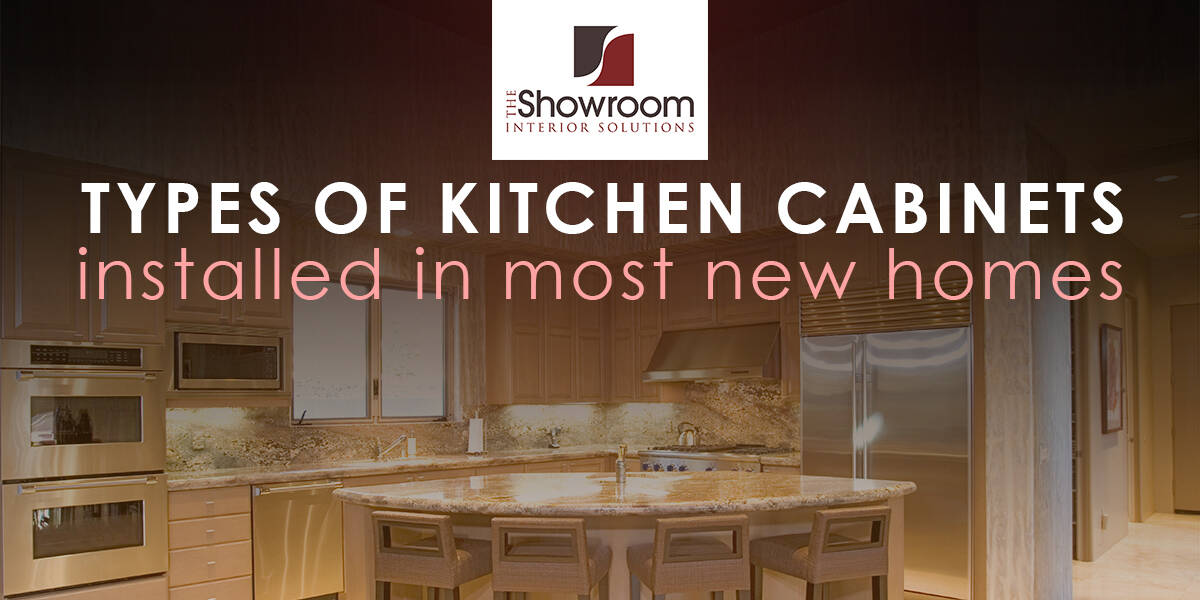The Showroom Interior Solutions, Olympia’s #1 Home Decor specialists, are here to help with all your home decor product needs. Specializing in cabinets, countertops, and flooring, today we’ll talk about kitchen cabinets. Your kitchen cabinets play a central role in your home’s aesthetic, and also in the usability of your kitchen. At The Showroom Interior Solutions, we help our clients find the ideal solutions for their homes, whether that’s new flooring, new cabinets, or countertops.
Of course, it helps to know a bit more about the most common types of cabinets installed in new homes today. In this post, we’ll explore the four most common cabinet types, as well as discuss some of the materials used for cabinet construction, and a great deal more.
Base Kitchen Cabinets
Base cabinets are those installed just above the floor and that support your countertops. You may also hear these called bottom cabinets or lower cabinets. In most situations, they are very sturdy because they need to hold not only the weight of everything in them but also the countertops and anything set on the counters.
Base cabinets include drawers, as well as cabinets where you can store things like pots and pans. In most cases, the kitchen cabinets installed in new homes today are two feet deep and three feet tall. However, in some cases, the cabinets may be up to 27 inches deep if it is a custom-designed solution. All base cabinets are installed on top of a four-inch toe-kick that raises the cabinets’ bottom above floor level and offers better usability. This brings the total height of the cabinets to 40 inches. Another inch or two will be added when the countertops are installed.
Upper Kitchen Cabinets
Sometimes called wall cabinets, upper cabinets are mounted on the wall above the base cabinets. Because they are not supported by a floor, they are lighter than base cabinets, but they must still be strong enough to support a significant amount of weight. These are frequently used for storing plates, bowls, glasses, coffee cups, and sometimes double as pantry space in some homes.
For most new homes, upper cabinets are narrower than their lower-placed counterparts. The average depth is 12 inches, but some can be up to 17 inches deep. There are several reasons that these cabinets are shallower than base cabinets, but the primary reason is to ensure that you have full use of your countertops. If the cabinets projected too far, they would block a lot of the space, rendering it unusable. The reduced width also helps make the cabinets lighter, reducing the load on the wall studs.
Upper cabinets often have solid doors, but may include decorative elements, such as stained or patterned glass or other inserts. These add unique touches to the home, bring in color, or allow your items to be displayed.
Utility Kitchen Cabinets
Sometimes called tall cabinets or pantry cabinets, these are taller than either base cabinets or upper cabinets. They’re generally designed to hold food or household supplies such as brooms and dustpans. They often stand around 83 inches tall, but some may be 84 to almost 100 inches tall depending on the builder and the design.
Tall cabinets are ideal for creating storage space and usually have solid doors so that the contents are not visible. You will often find these beside the refrigerator or in corners of the room. In addition to storage space, they can be used to add vertical accents to a kitchen.
Specialty Kitchen Cabinets
You can probably see some glaring omissions from the list of cabinets above. Where are the hutches? What about the space under the sink? What about the false front under the stovetop? What about those built-in wine racks you see? Those are all part of the kitchen cabinetry world, too, and they fall under the heading of specialty cabinets or units. As you can see from the partial list of types, these can be any number of sizes.
Common Cabinet Materials
We’ve covered the most common types of cabinets installed in new homes, but we need to talk about materials for a moment. These can vary greatly from one home to another depending on the price range of the home and the builder’s choices. Some of the most common choices include the following:
- Wood Veneer – If a builder wants the look of real wood without the cost, wood veneers are usually chosen. These are just thin sheaths of wood that are glued to the outside of another material. They look nice and are cost effective. However, they do not usually last that long, and they may not take well to painting in the future. Refinishing is usually not an option. New veneers may be installed, though.
- MDF – MDF is a type of particle board and it is used in place of wood in cabinet doors and fascia. Usually, it will have a wood-like laminated surface. These are the most affordable of all kitchen cabinets, but they are also the least likely to hold up well over time and through hard use. Often, the laminate covering the MDF will bubble up when exposed to moisture and will also wear through around handles and pulls where fingers touch the material frequently.
- Wood – Real wood is the material of choice for high-quality, durable cabinets that look great and will last for decades to come. While they come at a higher cost than other options, the fact that they do not need to be replaced for many, many years makes them cost-effective. Wood cabinets can also be refinished almost an infinite number of times, and they can also be painted with relative ease and some basic preparation when you’re ready for a change of appearance. Some wood kitchen cabinets come with a laminated paint finish that makes them easy to clean and maintain.
How Long Do Kitchen Cabinets Last?
The kitchen cabinets installed in new homes today may last for 10 years or longer. However, a lot of this depends on the quality of the material, how hard the cabinets are used, and how well they are maintained. MDF cabinets will usually last about 10 years if they are well cared for and not subject to abuse. After that point, the finish will begin to wear off and they will begin to suffer from a degraded appearance. However, if they are exposed to high moisture levels or are not maintained very well, they may fail much earlier than this.
Wood veneer cabinets usually last a little longer than plain MDF cabinets, but, again, this depends on how well they’re maintained and how much abuse they suffer. If cabinet doors are frequently slammed, or they’re exposed to high levels of moisture, they may fail as early as MDF cabinets.
Real wood cabinets are the longest lasting, and when properly maintained, can last the life of the home. They also hold up well to heavy use and even abuse. Moisture must be severe in order to really affect these cabinets, too, and if they are properly finished and sealed, even serious moisture may not cause warping or damage.
Kitchen Cabinet Trends to Know
At The Showroom Interior Solutions, we keep up with design trends in the industry so that we can help our clients achieve the look, feel, and usability level that they deserve. We have seen a number of kitchen cabinet trends come and go over the years, and we’re well aware of the hottest trends with today’s homeowners.
Colors – One of the more interesting trends in kitchen cabinets today is a shift away from natural wood finishes and toward using colors on cabinets. This is particularly true with neutrals such as light gray, dark gray and blue, but also yellow. Painted cabinets are particularly popular with those who want to create a contrasting look with their kitchen walls, but you may also want to draw inspiration from other colors within your home. For instance, if you have a yellow accent wall in the living room that connects to the kitchen, yellow paint for the island cabinets could connect the two together without overloading the eye.
Driftwood Look – The faded, distressed, weathered look of driftwood is becoming popular once more. You can see it in a range of home furnishings, from entertainment centers to sofa tables and even decorative wall clocks. It’s also being used more and more in the kitchen and makes a lovely statement. It creates a cool room temperature (color-wise) and can provide a surf-inspired look or can give the kitchen a vintage look. This is particularly true when custom kitchen cabinets are paired with other unique materials, such as natural stone, wrought iron, and dark wood flooring, for instance.
Streamlined – Call it clean, minimal, or modern art-inspired, but the streamlined look is really becoming popular in today’s kitchen cabinetry world. You’ll find that this style runs a wide gamut, from cabinets with no visible handles or pulls to simple cabinetry without any decorative embellishments. The clean, smooth lines help put the focal point on what goes on in the kitchen – family life – rather than on the design elements. This is particularly beneficial when paired with stainless steel or black appliances.
Open Dish Storage – You’ve seen them before, the slotted shelves that allow you to store individual plates. These types of specialty cabinets were used in the past, but they’re gaining traction once more today. They are great ways to ensure that you can always get to plates when you need them, and if you have an eclectic collection of different colors and sizes, it makes a good aesthetic addition to your kitchen, as well. Of course, they’re not ideal for all kitchen themes, and work well with French country, American country, bohemian, and other less formal styles.
Undercabinet Lighting – Unless you’ve been living under that proverbial rock, you’re aware of this trend. Undercabinet lighting provides a way to deliver understated task lighting throughout the kitchen without having to use the home’s main lights. This can be used for accents, for work lighting, for use at night, and many other situations. Undercabinet lighting can be embedded directly in the cabinetry, or it can be added later. As a note, later modifications can often detract from your kitchen’s aesthetics, so it’s almost always better to go with built-in lighting during cabinetry installation.
In Conclusion
With a better understanding of the various types of kitchen cabinets installed in new homes, you should be able to identify what you have in your own home. You should also be able to determine what direction you want to go if and when it comes time to remodel your kitchen. At The Showroom Interior Solutions, we offer the highest-quality real wood cabinets, a broad range of finish and color choices, and can custom design the ideal solution for your home and your life. We invite you to contact us today at 360-400-7469.



